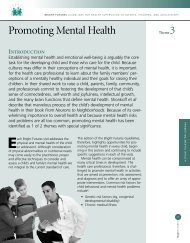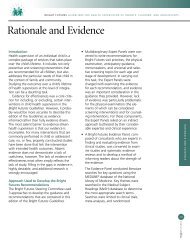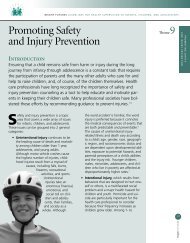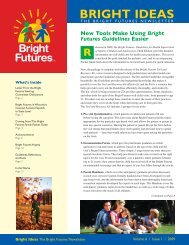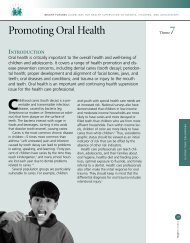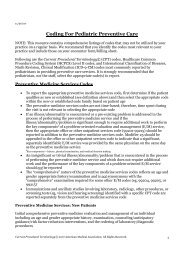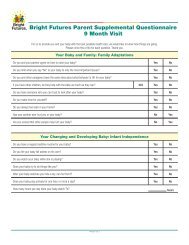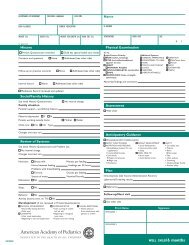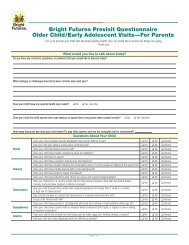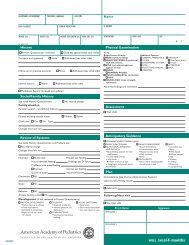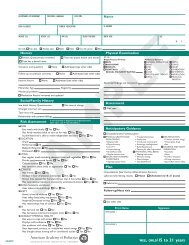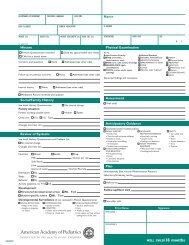POCKET GUIDE - Bright Futures - American Academy of Pediatrics
POCKET GUIDE - Bright Futures - American Academy of Pediatrics
POCKET GUIDE - Bright Futures - American Academy of Pediatrics
You also want an ePaper? Increase the reach of your titles
YUMPU automatically turns print PDFs into web optimized ePapers that Google loves.
Adolescence<br />
52<br />
<strong>Bright</strong> FUTURES<br />
■ Positive body image. (People come in unique sizes and<br />
shapes, within a range <strong>of</strong> healthy body weights.) (see tips<br />
for Fostering a Positive Body image Among Children<br />
and Adolescents.)<br />
■ Assuring adolescents that they are loved and accepted as<br />
they are, regardless <strong>of</strong> their size and shape.<br />
physical Activity<br />
■ engaging in 60 or more minutes <strong>of</strong> daily physical activity.<br />
— Aerobic: either moderate-intensity (hiking, skateboarding)<br />
or vigorous-intensity (running, bicycling) aerobic<br />
physical activity daily, and include vigorous-intensity<br />
physical activity at least 3 days a week.<br />
— Muscle-strengthening: include muscle-strengthening<br />
physical activity (climbing trees, sit-ups) at least 3 days<br />
a week.<br />
— Bone-strengthening: include bone-strengthening<br />
(weight-bearing) physical activity (jumping rope,<br />
playing basketball) at least 3 days a week.<br />
■ incorporating physical activity into daily life (through<br />
physical education at school and activities with family<br />
and friends).<br />
■ For adolescents with special health care needs, engaging<br />
in physical activity for cardiovascular fitness (within limits<br />
<strong>of</strong> medical or physical conditions).<br />
■ Wearing appropriate safety equipment (helmets, pads,<br />
mouth guards, goggles) when physically active.<br />
■ Finding safe settings for physical activity.<br />
■ Drinking water when physically active.<br />
■ Not having a television in the adolescent’s bedroom.<br />
■ Limiting total entertainment media time (watching television,<br />
playing computer or video games) to no more than<br />
1 to 2 hours <strong>of</strong> quality programming a day.<br />
■ reducing sedentary behaviors (watching television, playing<br />
computer or video games, especially if the adolescent<br />
is overweight.<br />
substance use<br />
■ Consuming excessive quantities <strong>of</strong> caffeinated beverages<br />
(s<strong>of</strong>t drinks, c<strong>of</strong>fee, energy drinks).<br />
■ Dangers <strong>of</strong> using alcohol, tobacco, and other drugs.<br />
■ Dangers <strong>of</strong> using performance-enhancing products<br />
(protein supplements, anabolic steroids).



